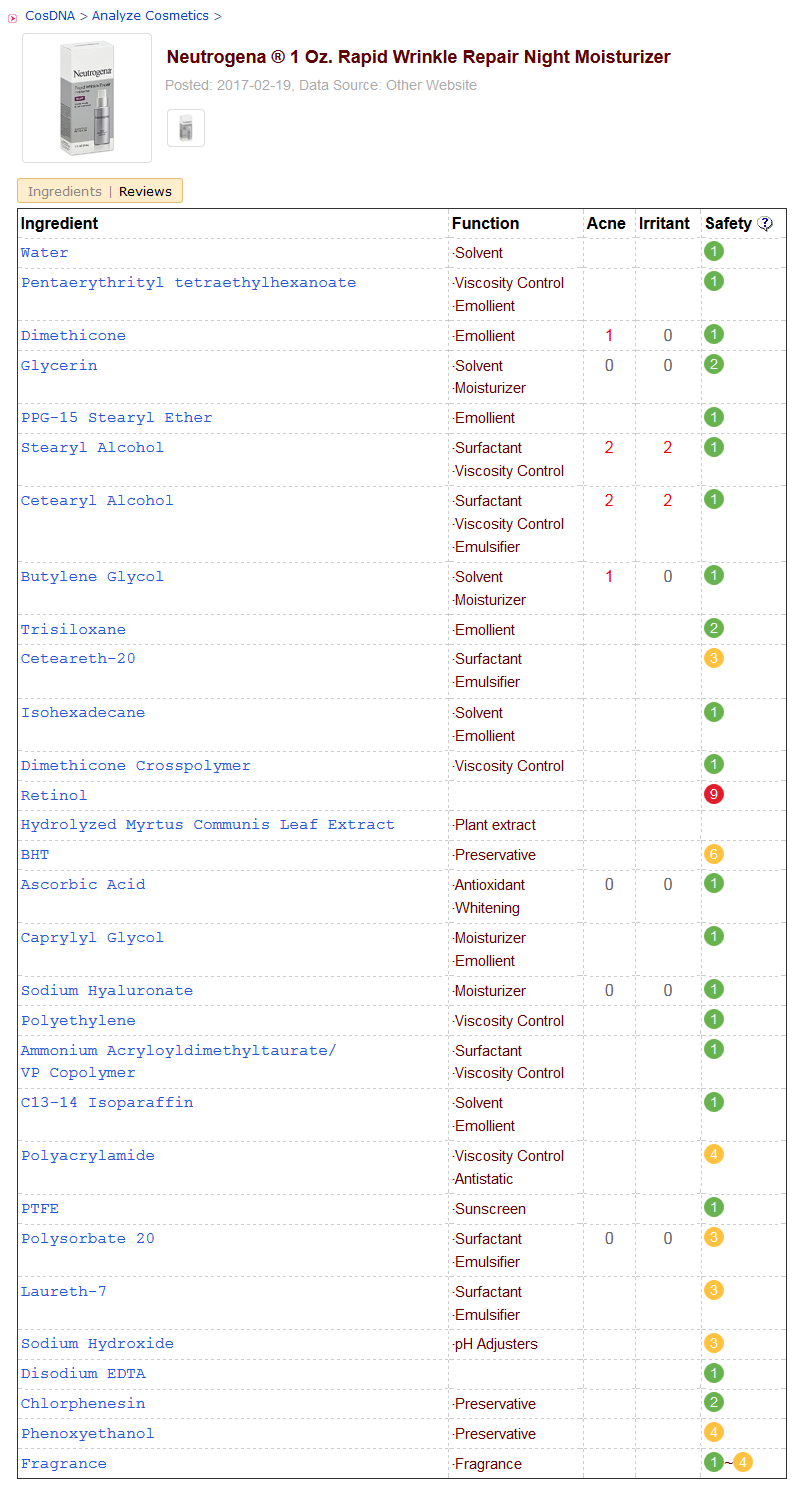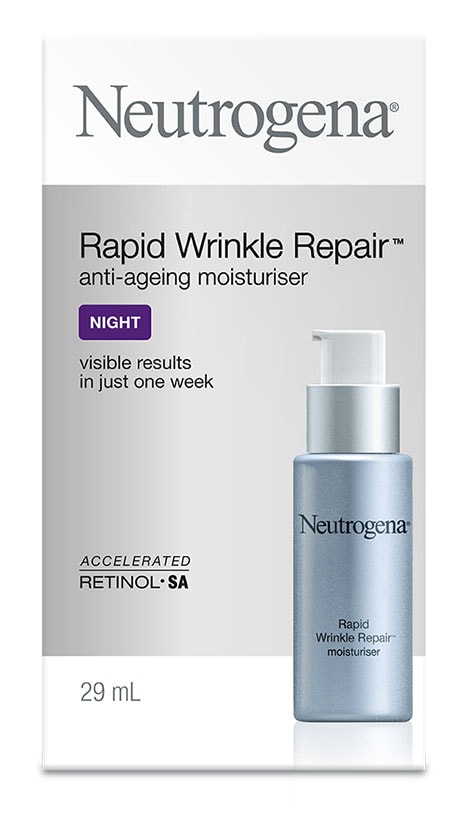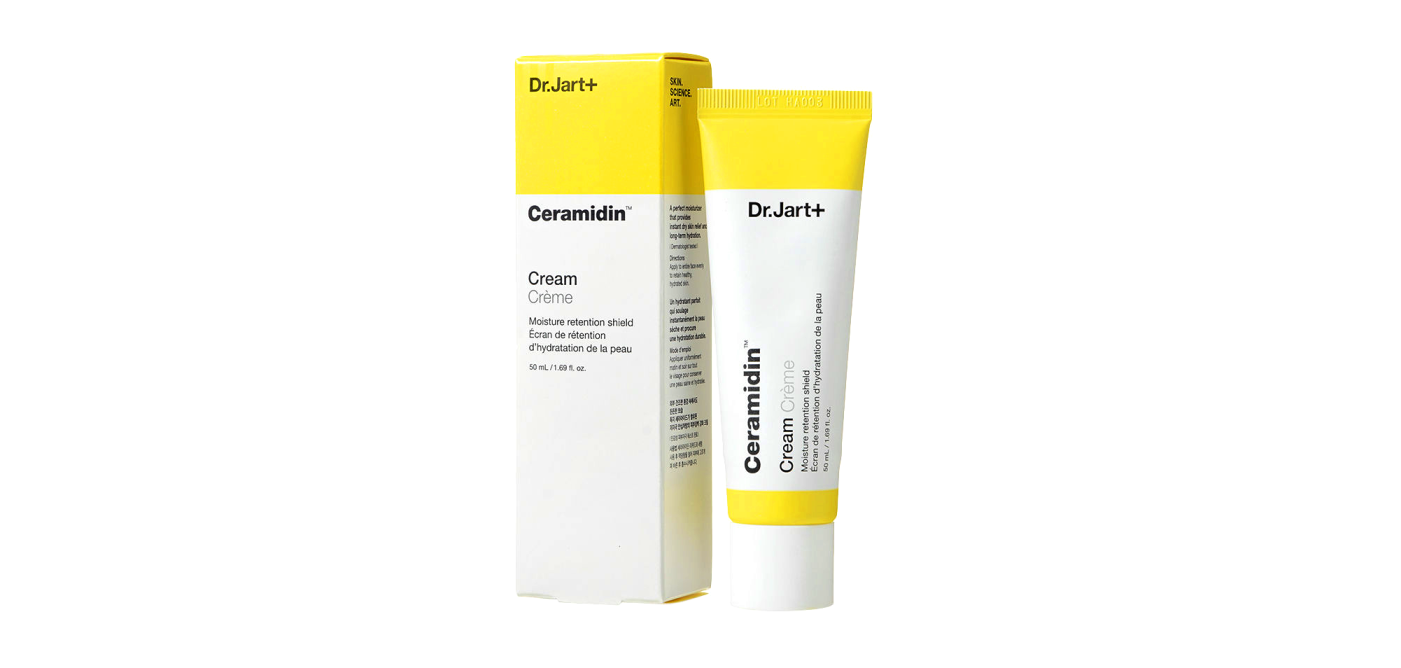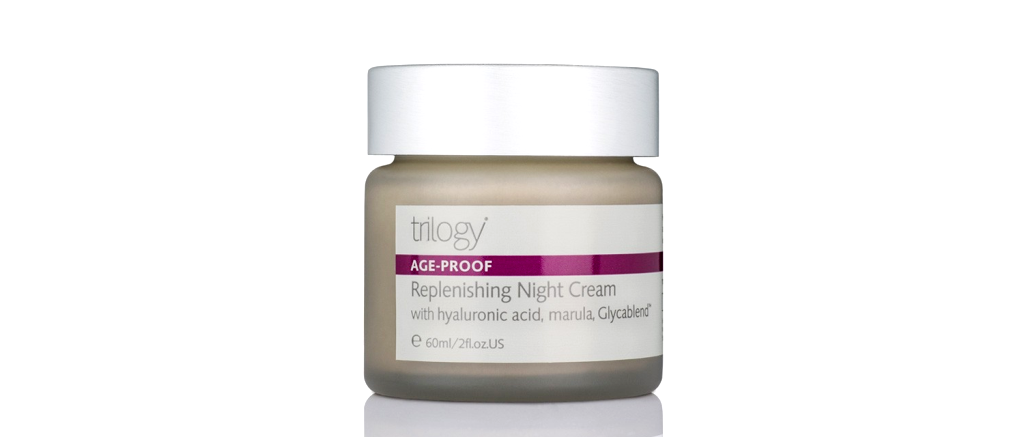
Neutrogena Rapid Wrinkle Repair
the claim
The Neutrogena Rapid Wrinkle Repair anti-ageing night time moisturiser claims to help reduce the visible signs of ageing.
- Improves the look of fine lines and wrinkles, including crow’s feet and cheek wrinkles
- Brightens and evens skin’s tone
- Smooths fine lines and texture
- Rejuvenates and nourishes skin for a more radiant look

the science
Retinol is a Vitamin A derivative which is considered a superstar anti-ageing ingredient, supported by over 40 years of scientific research. It works to increase cell turnover plus stimulate collagen and elastin production. Results include a reduction in the appearance of fine lines and wrinkles, improvement in uneven skin tone and resurfacing for smoother skin texture. Retinol products make skin more sensitive to UV exposure so it is imperative that they be followed with high protection sunscreen during the day.
Retinol is commonly used in cosmetics while retinoids are available by prescription only. Associate Professor Greg Goodman from the Dermatology Institute of Victoria advises that retinol treatments should be introduced slowly to your routine, particularly for those with sensitive or irritated skin. It is best used in the evening and avoided during pregnancy and breast feeding. “It is a reparative preparation and night is a time for repair”.
Neutrogena state that their Accelerated Retinol SA (Retinol Sustained Action) is a patented technology that is supposed to keep retinol stabilized and at its maximum effectiveness, working for a full 12 hours after application, thus delivering noticeable results within 7 days. Studies conducted by Neutrogena (as such not independent and not substantiated by a neutral authority), have proven it to be a superior form of Vitamin A, more effective than Pro-retinol or Retinyl Palmitate. The formula also comprises glucose complex to accelerate renewal of the skin’s surface and hyaluronic acid, to plump the skin with moisture and combat irritation that may arise through application of the retinol itself.
Sodium hyaluronate is naturally found in the skin. It is able to hold more water (up to 1,000 times its weight) than any other natural substance. When applied topically, it can effectively penetrate into the dermis to maximise skin hydration. This results in smoother, softer skin and a decreased appearance of wrinkles.

Hydrolyzed Myrtle Leaf Extract (Myrtus communis) is derived from myrtle tree leaves. Myrtle is an effective acne treatment and can also improve other skin imperfections when topically applied in very limited concentrations. The organic compounds and powerful antioxidants in myrtle accelerate cell healing.
Ascorbic acid (Vitamin C) displays antioxidant qualities and is well-known for its brightening effects, treatment of skin damage from overexposure to the sun and its collagen synthesis properties for tighter skin.
Other ingredients in the formula are added for their emulsifying, preservative and viscosity control properties. Collectively, the components within the formula appear to address the manufacturer’s performance claims.
the ingredients
Water, Pentaerythrityl Tetraethylhexanoate, Dimethicone, Glycerin, PPG-15 Stearyl Ether, Cetearyl Alcohol, Stearyl Alcohol, Butylene Glycol, Ceteareth-20, Isohexadecane, Retinol, Sodium Hyaluronate, Dimethicone Crosspolymer, Trisiloxane, Phenoxyethanol, Ammonium Acryloyldimethyltaurate/VP Copolymer, Caprylyl Glycol, Polyacrylamide, Polyethylene, Fragrance, C13-14 Isoparaffin, Chlorphenesin, Hydrolyzed Myrtus Communis Leaf Extract, Polysorbate 20, PTFE, BHT, Disodium EDTA, Laureth-7, Ascorbic Acid, Sodium Hydroxide
the packaging
The packaging is sleek. A fully opaque glass bottle contains the cream. Dispensing is via a white pump action top with a lockable twist.
the analysis
This is a formula whose anti-ageing active is retinol. The CosDNA analysis rates it fairly with a flag raised against retinol. The EWG Cosmetic Database rates it 7/10, a high hazard, primarily due to the inclusion of retinol (concerns raised including “Developmental/reproductive toxicity, Biochemical or cellular level changes, Cancer, Organ system toxicity (non-reproductive)”) and fragrance (concerns raised including “Allergies/immunotoxicity, Miscellaneous, Irritation (skin, eyes, or lungs), Organ system toxicity (non-reproductive), Ecotoxicology”). All other ingredients rate moderate to low in terms of their hazard level.

the application
Apply at night after serum to cleansed face and neck. Smooth a pearl-sized amount evenly in gentle massaging strokes until fully absorbed. Turn pump to “closed” position when not in use.

the scent
There is a definite scent with this formula. Although not overpowering or unpleasant, it is obvious. The smell is fruity, much like apples.
the cost
The Neutrogena Rapid Wrinkle Repair 29ml sells for around AUD$40.00.
the availability
This product is widely available in supermarkets, pharmacies and department stores as well as online.
the expiry
This product has a shelf life of 2 years since manufacture. There is no recommended use by date upon opening.
the performance
The cream dispenses cleanly with a lockable pump action minimizing contamination risk. A couple of squirts will cover face and neck sufficiently. It does emit a fruity fragrance so those sensitive may find it irritating. It is a lightweight cream that applies nicely, absorbing fully without any greasiness or oily residue, leaving a matte finish. The skin feels hydrated after application. I have used a full bottle of this over a course of around three months and enjoyed it.

Although it can be difficult to judge how much impact any product has on fine line reduction, I believe there may be a tiny amount of ever-so-slight wrinkle softening that can be attributed to this product.
Neutrogena are secretive about the concentration of each ingredient in the formula. I tried to contact them by phone ringing their Customer Care Centre, but even when I called during their advertised time frame (on multiple occasions), their consumer line defaulted to messages requesting me to call back during business hours with no option to actually speak to anyone. An email was sent but no reply was received. I scanned their facebook page, and found that someone else shared my curiosity, raising the same question about the amount of retinol present in this product. This was the reply posted:
Unfortunately we cannot declare the percentage of ingredients in our formulas as they are proprietary. However, we can assure you that the ingredient is present at an effective concentration and has been clinically tested by independent dermatologist and proven to deliver the claims as cited on pack and in advertising.
Update: Since posting this review, a Johnston & Johnson representative contacted me (a month after raising the query) with a near identical response.
So, they stand by their claim that the percentage of retinol (together with the other actives) present in this product is sufficient to make you look younger within 7 days, because that’s what it says on the packaging. If that’s the case, then this product fails to meet its objectives. I did not see results in a week, not even two or three weeks. In fact, there is a huge collection of online articles and research stating that results from low strength, non-prescription retinol application take at least 2-3 months and more likely 4-6 months to show any sign of improvement. According to the Advanced Dermatology Medical Team, “Within 10 to 12 weeks of using a retinol cream, results can usually be seen, however in some cases, it does take longer.”
Furthermore, Dr Susan Mayou, a consultant dermatologist at London’s Lister and Queen Mary University Hospitals believes that claims of wrinkle reduction due to retinol treatments in low concentrations are simply an exaggeration. “If Retin-A (prescription only) takes two years to work, then a Retinol product – which is far more gentle – cannot possibly do the same job in a matter of weeks.”
As such, touting skin rejuvenation and wrinkle improvement within 7 days of use is misleading and simply nonsensical. It’s a good cream but it’s not a rapid wrinkle treatment.
the conclusion
“Rapid wrinkle repair” is an optimistic name for any cream! It really is setting you up for a fall before you even begin. Wrinkles are nature’s way of telling us we’re ageing. They can’t be prevented nor removed rapidly! However, this is a good cream. It has a nice list of actives with proven anti-ageing abilities.
Anti-wrinkle creams can cost a fortune so a big advantage of this one is that it is not super cheap, but definitely affordable especially when you purchase during sales. (I got mine for AUD$28). It doesn’t act as rapidly as the name might suggest to combat signs of ageing, but for what it delivers, competitive comparisons and the price point, it is a solid performer.
the references
Neutrogena wesbite
8 Impressive Benefits of Myrtle Organic Facts
What you need to know about retinol before you start using it Lilith Hardie Lupica
Vitamin C Truth in Aging
Hyaluronic Acid & Sodium Hyaluronate Truth in Aging
Difference Between Retinol and Retinol SA Karen Lac
Retinol Cream Advanced Dermatology
Retinol: a dermatologist says Daily Mail Australia
the disclaimer
Please read in context with my disclaimer.




